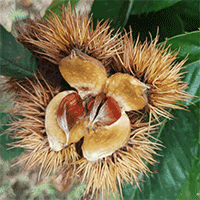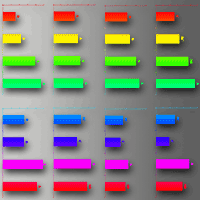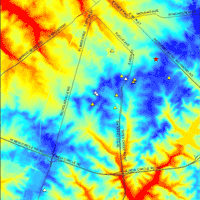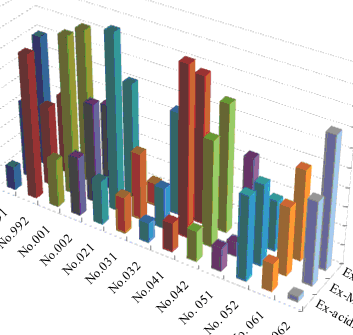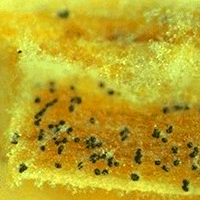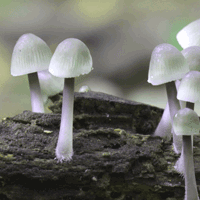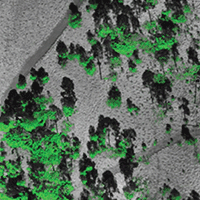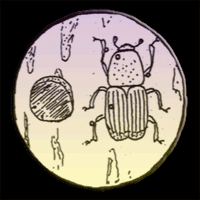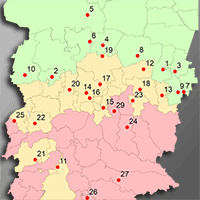
Phytopathogenic fungi in forest nurseries of Middle Siberia
Marina A Sheller (1-2) , Elena A Shilkina (1), Aleksey A Ibe (1), Tatyana Y Razdorozhnaya (1), Tatyana V Sukhikh (1)
iForest - Biogeosciences and Forestry, Volume 13, Issue 6, Pages 507-512 (2020)
doi: https://doi.org/10.3832/ifor3507-013
Published: Nov 05, 2020 - Copyright © 2020 SISEF
Research Articles
Abstract
The paper presents the results of phytopathogenic fungi determination in bare-root forest nurseries of Middle Siberia. Genetic analysis of pathogenic microflora of Pinus sylvestris L., Pinus sibirica Du Tour and Picea obovata Ledeb. seedlings allowed identification of 17 genera of micromycetes: Phoma Sacc., Lophodermium Chevall., Sclerophoma Höhn. (teleomorph Sydowia Bres.), Cladosporium Link, Alternaria Nees, Typhula (Pers.) Fr. etc. Most frequently detected fungi represented genera Phoma (23.7 %) and Lophodermium (23.6 %). Pinus sylvestris L. seedlings harboured the highest diversity of fungal taxa. Seven genera of microscopic fungi (Phoma sp., Didymella sp., Alternaria sp., Cladosporium sp., Lophodermium sp., Gremmenia sp., Sclerophoma sp.) were detected in all studied forest zones: taiga, forest-steppe and Southern-Siberian mountain. The obtained results demonstrate the usefulness of DNA analysis for the identification of phytopathogenic fungi in forest nurseries of Middle Siberia with several implications for increasing the efficacy of forest management.
Keywords
Forestry, Forest Nurseries, Phytopathogens, Conifers, DNA analysis, ITS Region, Phytopathological Monitoring
Authors’ Info
Authors’ address
Elena A Shilkina
Aleksey A Ibe 0000-0002-3534-532X
Tatyana Y Razdorozhnaya
Tatyana V Sukhikh
Department of Monitoring of Forest Genetic Recourses, Branch of the Russian Centre of Forest Health - Centre of Forest Health of Krasnoyarsk krai, Akademgorodok 50a/2, 660036 Krasnoyarsk (Russia)
Reshetnev Siberian State University of Science and Technology, Krasnoyarskii rabochii prospect 31, 660037 Krasnoyarsk (Russia)
Corresponding author
Paper Info
Citation
Sheller MA, Shilkina EA, Ibe AA, Razdorozhnaya TY, Sukhikh TV (2020). Phytopathogenic fungi in forest nurseries of Middle Siberia. iForest 13: 507-512. - doi: 10.3832/ifor3507-013
Academic Editor
Federica Brunoni
Paper history
Received: May 15, 2020
Accepted: Sep 03, 2020
First online: Nov 05, 2020
Publication Date: Dec 31, 2020
Publication Time: 2.10 months
Copyright Information
© SISEF - The Italian Society of Silviculture and Forest Ecology 2020
Open Access
This article is distributed under the terms of the Creative Commons Attribution-Non Commercial 4.0 International (https://creativecommons.org/licenses/by-nc/4.0/), which permits unrestricted use, distribution, and reproduction in any medium, provided you give appropriate credit to the original author(s) and the source, provide a link to the Creative Commons license, and indicate if changes were made.
Web Metrics
Breakdown by View Type
Article Usage
Total Article Views: 37145
(from publication date up to now)
Breakdown by View Type
HTML Page Views: 31315
Abstract Page Views: 2391
PDF Downloads: 2731
Citation/Reference Downloads: 2
XML Downloads: 706
Web Metrics
Days since publication: 1860
Overall contacts: 37145
Avg. contacts per week: 139.79
Citation Metrics
Article Citations
Article citations are based on data periodically collected from the Clarivate Web of Science web site
(last update: Mar 2025)
Total number of cites (since 2020): 4
Average cites per year: 0.67
Publication Metrics
by Dimensions ©
Articles citing this article
List of the papers citing this article based on CrossRef Cited-by.
References
Sustainable forest management is one of Russia’s economic problems. In: Proceedings of the “Forest of Russia: Policy, Industry, Science and Education”. St. Petersburg (Russia), 22-24 May 2019. IOP Conference Series - Earth and Environmental Science 316 (2019): 012086.
CrossRef | Gscholar
Diseases of Pinus sylvestris L. and Pinus sibirica Du Tour in provenance trial and forest nurseries of Krasnoyarsk krai and Khakassia. Conifers of the Boreal Area 27 (3-4): 55-60. [in Russian with English abstract]
Gscholar
Biomonitoring of conifer seedling diseases in forest tree nurseries of the middle Siberia. Siberian State Technological University, Krasnoyarsk, Russia, pp. 264 [in Russian]
Gscholar
Program and methodology of work under item 59 of the Action plan “The State Coordination Program for the Development of Biotechnology in the Russian Federation for 2011-2020”. Order no. 1247-p (18 Jul 2013), Government of the Russian Federation, Moscow, Russia, Web site.
Online | Gscholar
Diseases in Czechoslovak forest nurseries. In: Proceedings of the 1st Meeting of IUFRO Working Party S2:07-09 “Diseases and Insects in Forest Nurseries” (Sutherland JR, Glover SG eds). Information Report BC-X-331, Pacific Forestry Centre, Canadian Forestry Service, Victoria, BC, Canada, pp. 37-49.
Gscholar
Ecological and biological justification of the use of fungicides in the protection of Pinus sylvestris L. seedlings from phytopathogenic micromycetes. Ph.D. thesis, Sukachev Institute of Forest SB RAS, Krasnoyarsk, Russia, pp. 50. [in Russian]
Gscholar
Diseases and insects in forest nurseries in Canada. In: Proceedings of the 1st Meeting of IUFRO Working Party S2:07-09 “Diseases and Insects in Forest Nurseries” (Sutherland JR, Glover SG eds). Information Report BC-X-331, Pacific Forestry Centre, Canadian Forest Service, Victoria, BC, Canada, pp. 25-32.
Gscholar
Amplification and direct sequencing of fungal ribosomal RNA genes for phylogenetics. In: “PCR Protocols: A Guide to Methods and Applications” (Innis MA, Gelfand DH, Sninsky JJ, White TJ eds). Academic Press, San Diego, CA, USA, pp. 315-322.
Gscholar

